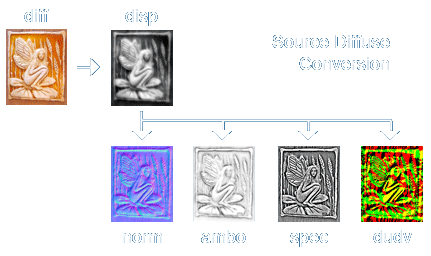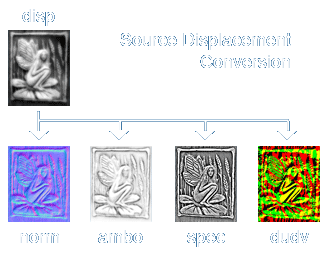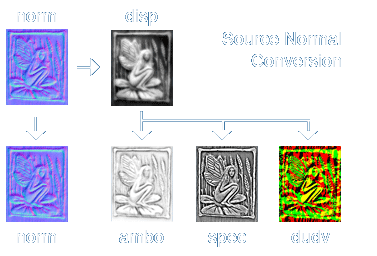Source Map Types
There are currently three types of source maps that can be converted to other maps. The three map types are diffuse (color texture), displacement (height map), and normal map. Below is a description of the source maps and how they are converted to other maps supported by ShaderMap Pro.
Diffuse Maps
Diffuse maps represent the absorption of light. Diffuse maps are what people call "textures". They are
the color textures or photographic textures usually applied to 3d models. ShaderMap Pro first converts diffuse maps
to displacement maps then creates other maps from the displacement map.
It is important to note that controlling the displacement property values has a direct influence on all other maps (normal, ambient occlusion, specular, dudv). If the displacement map is disabled, the default values are used to create a hidden displacement map used to create other maps. This displacement map is the main dependency of other maps.
Below is a graph showing the structure of maps when converting from a diffuse map:

Displacement Maps
Displacement maps are often called "Height Maps". A displacement map is represented by grayscale colors
where white is the highest point in the map and black is the lowest. ShaderMap can create all supported maps
directly from a displacement map. For this reason it is fastest to create maps from a displacement source.
Below is a graph showing the structure of maps when converting from a displacement map:

Normal Maps
Normal Maps store normal vectors in the RGB channels of an image. Normals are used to compute the lighting
of a surface in shader programs. ShaderMap Pro first converts normal maps to displacement maps then
creates other maps from the displacement map.
Like the diffuse map the normal map to displacement conversion allows direct influence on all other maps via the displacement properties. If the displacement map is disabled, the default values are used to create a hidden displacement map for other map creation.
